This is a bit of a break from our usual fare here, more in keeping with the Blah Blah Blog segments that I repost from my old Marvel blog that were relevant to my work situation. But I typically refrain from talking about that kind of thing here, as it seems somehow immodest and self-serving to me. Nevertheless, I came across notes I had put together some fifteen years ago for an entry that I was going to make when Blah Blah Blog was an ongoing concern–the difficulty I had run into was that I could only come up with four examples. Well, in the time since, I’ve been able to round out this list with number five–and they’re all a good caution for the editors and would-be editors of today, signposts of pitfalls to avoid. So what the hell, here is a list of Five Comic Books That Almost Got Me Fired.
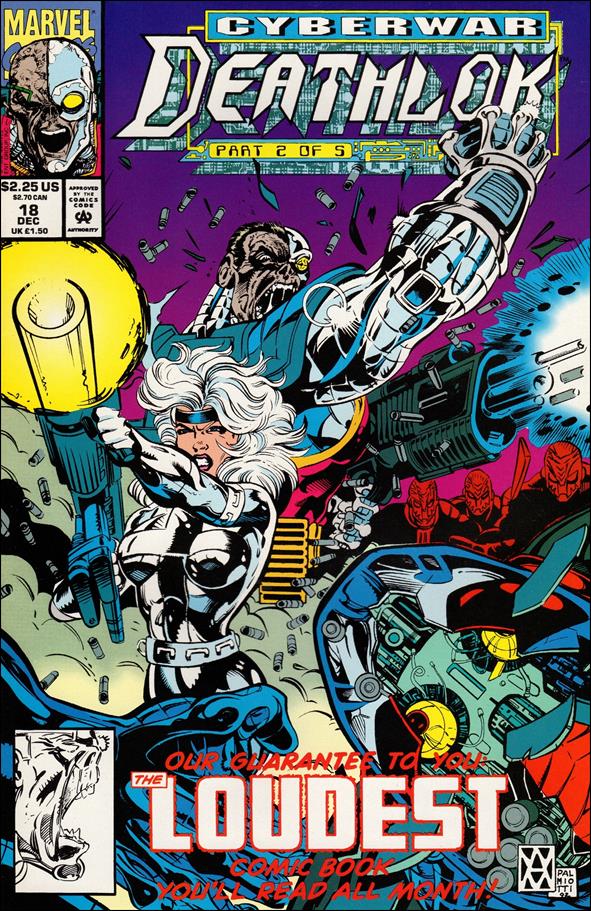
DEATHLOK #18: That cover copy is fun, but largely unreadable against that background. Anyway, the issue with this particular book wasn’t actually my fault, but it was the first time I’d experienced that world-ending panic of finding out about a situation and realizing that it was possibly going to cost you your job. You see, in the days when this issue of DEATHLOK was put together, everything was still being pasted up on the actual boards to be sent to press–nothing was yet digital as it is today. And for most Marvel titles, there would be two editions, one for the Direct Sales marketplace of comic book specialty shops, and one for the Newsstand Marketplace of candy stores and 7-11s and newsstands. What that meant is that a different corner box and UPC box had to be put together for each version, one for the Direct Market (seen on the copy above) and one for the Newsstand Market that would include the distributor’s codes and other such info. The way this was done is that one version was pasted up directly onto the art board, and the other was packaged in an envelope attached to the back, to be stripped in at the printer.
Now, the other thing you need to understand is that the issue after this, #19, was going to feature an enhanced cover, and as such was being up-priced to $2.25 (the regular price at this time was, if I recall properly, $1.75). And the person who generated those UPCs and corner boxes made a mistake on the Direct Edition for this issue–listing it at the higher $2.25 price. But because the version that was pasted up on the board happened to be teh Newsstand version, I didn’t see the mistake–it wasn’t the responsibility of the editor to check such things, but rather than duties of the sales department as the cover was circulated for sign-off prior to going to press. And whoever it was didn’t check this cover properly.
I can remember the shock and horror I felt that Wednesday when I stopped into Jim Hanley’s Universe (a local Manhattan comic book store) for the new books and saw the above cover sitting on the racks with its incorrect price. I felt as though I was having a heart attack, and I thought my number was up for certain. What’s worse, in those days before cell phones, I had to wait until I could reach home before I could even begin to make any calls about it, and I was freaking out the entire time. In the end, the next day, the decision was made not to recall and reprint the book, but to let it stand with the wrong price. According to our sales team, retailers really weren’t having any reaction to it or seeing any pushback from their customers. Which seems odd to me–I maintain to this day that this snafu had to be one of the factors that led to sales dropping on the title (though it certainly wasn’t responsible for everything–I made a bunch of mistakes on this book.) And as far as I can remember, nobody else treated it as a big deal.

CARNAGE: MIND BOMB #1: This book was published during that brief year when Marvel editorial had been split into five smaller fiefdoms, each headed up by a separate editor in chief. In this case, the EIC of the Spider-Man family of titles was Bob Budiansky, which worked out well for me, as I came in as Bob’s assistant editor originally (and intern before that.) For all that I had a strong working relationship with Bob, for a myriad of reasons I didn’t work directly on the main core Spider-Man titles. Instead, I would up helming many of the satellite books, such as UNTOLD TALES OF SPIDER-MAN, GREEN GOBLIN, SPIDER-MAN TEAM-UP, VENOM and so forth. When Bob was given the Spider-Man books, he was instructed by management that his goal for the year was to increase sales on the line by 10%, and this was a goal that he pursued zealously. This was in part the reason why the long-running Clone Sage kept on running–because the sales department insisted that it was driving interest in the titles, and that to end it would spell their doom.
Anyway, as we attempted to build out additional Spider-Man series, Bob was very liberal in what he felt a Spidey book could be about. He saw the range that Bob Harras was able to get out of the X-Men line, and he felt as though the same thing could be true for Spider-Man, despite the fact that it was built around a single character. That need was great enough that Budda wanted to do a special featuring Carnage, the incredibly popular serial killer character who had been spawned from Venom. I can’t say that I was any fan of the character, but that was the mission, and so I had to take it on. Bob very specifically wanted the book to push the envelope a bit more than the typical Spidey release might do, and to that end, he had arranged for it to be published without the approval of the Comics Code. Marvel was still skittish about branding anything as Mature Readers, but this was about as close as we could come. And since it was the mid-1990s, it was decided to up-price the book by giving it enhanced covers with red foil. (Everything that is red on the image above was shiny red foil on the printed book.)
Now, the problems here were twofold. First off, by the time the book actually saw print, the Five-EIC experiment had been concluded and Bob had actually been laid off by the company–this despite the fact that he had been the only one of the five EICs to meet the stated goal that he’d been given. The second problem was that when the cover was put together, the Bullpen production person put the Comics Code label on it anyway–and neither I nor anybody else who signed off on it noticed until after teh covers had been printed and it was too late to do anything about it.
Marvel President Terry Stewart started getting complaints about the contents of the story just as soon as it hit the stands, and I remember being called to his office for the first and only time to answer for it. It was an uncomfortable conversation, made more so by the fact that the person who had given us permission to push things in a Mature Readers direction was no longer around to confirm that. Terry wasn’t specifically upset about the Code symbol being on it–although that was the cherry on top for him–he was unhappy about the contents of the story in general, and the response from certain friendly retail outlets. But somehow, in the maelstrom of change of that moment, this situation also passed and I somehow survived–which is incredible, as Marvel had just gotten done laying off something like 40% of the editorial staff and one more body there wouldn’t have made any real difference. Still, the fact remains: even though it wasn’t the problem by itself, I should have caught that Comics Code label on that cover before the book went to press.
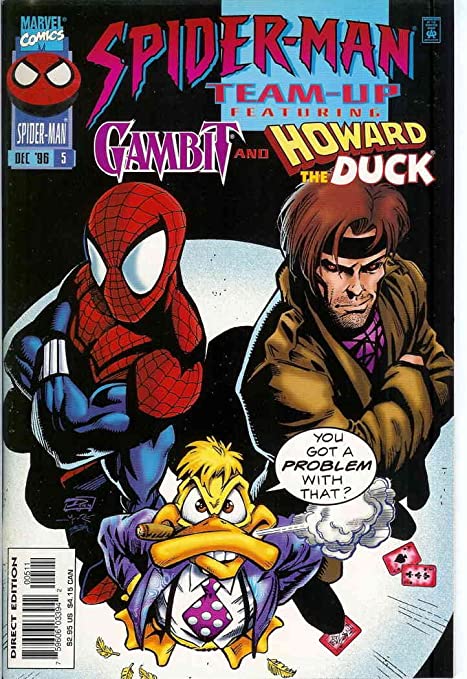
SPIDER-MAN TEAM-UP #5. This one has been spoken about at great lengths elsewhere, but I’m going to try to summarize things really quickly. Interested parties are encouraged to seek the longer explanation out. Anyway, after the five editorial divisions were folded back together under Bob Harras, I continued to work on a number of Spider-Man satellite projects, one of which was SPIDER-MAN TEAM-UP, a double-sized quarterly version of MARVEL TEAM-UP, just featuring Spider-Man’s name in teh title for better sell-through and order form placement. This book came out during the period when Marvel was in turmoil–not yet quite in bankruptcy I don’t believe, but definitely being pulled back and forth by rival claimants each of whom had designs on owning the company. As such, mandates and directives changed on an almost day-to-day basis, and something that was important one day would be utterly meaningless the next.
Somewhere along the line, I get the sense that there was some interest in doing something with Howard the Duck–whether that was a proposed television project or movie or something. Clearly, it never went anywhere. But on the week it was talked about, Bob Harras came to my office and asked me if we could have Spider-Man team up with Howard the Duck as soon as possible. Speaking with Kurt Busiek about this, it became apparent relatively quickly that the only Howard stories that had been any good up tot hat point had been written by the waterfowl’s creator Steve Gerber. Gerber had had a rocky relationship with the company, but if we wanted to do a new Howard story, reaching out to him to write it seemed like the best option.
Now, Gerber was a bit reticent to sign on to do this story, but after a few days’ though, he came to me with a proposition. See, he had been retained by Erik Larsen to do a Savage Dragon team-up story with his other creation, Destroyer Duck (a character that he had originated to help finance his then-lawsuit against Marvel for ownership of Howard.) for Image. And so what he wanted to do was an “unofficial crossover” between the two stories. This was something that had been done a number of times in the looser confines of the 1970s (I wrote a whole piece about them here: https://tombrevoort.com/2020/06/21/5bc-five-best-unofficial-marvel-and-dc-crossovers/ ) The thing was, I was uneasy about not knowing what would be in the Dragon/Destroyer book and I said so. Gerber gave me his word that he wouldn’t do anything in that story that would cause me any problems–and so, like a sucker, I agreed to go along with it.
The timing on this next bit is a bit difficult to parse so many years after the fact, but I prefer to think that Gerber was genuine in his initial promise to me. But that didn’t last long. Because given whatever conversations had been taking place about Howard teh Duck, Bob Harras had visited other offices besides my own, stumping for appearances of the Duck. And so suddenly, Howard was going to be showing up in GHOST RIDER, and GENERATION X, and in his own One-Shot Special as well as in this SPIDEY TEAM-UP story. And Gerber felt like he had been played, like his involvement was being used to give his tacit stamp of approval to whatever else was being done with his character. he and I had a conversation about this, and I told him that I understood and respected his position, and that if he had to step away from doing the TEAM-UP story, that would be fine–somebody else would just wind up writing it. But after a day or so, he agreed to continue on it.
It all hit the fan just before the Thanksgiving break of that year. I had occasion to speak with Howard’s agent about some other non-Gerber-related business, and he mentioned to me how angry Gerber was with all of us and that he had posted something on a then-nascent message board speaking of his plans. This was back in teh days of dial-up, and I can remember that evening frantically ripping programs out of my laptop so that I could free up enough memory on the thing to be able to dial into Gerber’s web page and read whatever he had written. There, he gave an account of his version of events, and declared that he was going to do something subversive in the DRAGON?DESTROYER book that would be like a kick in Marvel’s balls. As it turned out, what he did was to add in a scene set within a common sequence in which Howard and his girlfriend Beverly were spirited away and replaced with a couple of pod people clones. I wouldn’t know this for a number of months until the book finally went on sale (the two books were intended to come out at the same time, but the DRAGON/DUCK book came out months late–Image was having difficulty shipping titles on time during that period.)
I thought for sure that this was going to be my demise–but as in earlier instances, once everything came out about this, nobody on the Marvel side really cared. Which was fortunate for me, because I deserved what I got for getting myself into that situation in the first place. It was also good that Gerber lived on the West Coast, as had he been more local, I have no doubt that I would have driven over to his home in a rage and done violence to him, so angry was I at this betrayal and turn of events. Again, though, all my own fault.
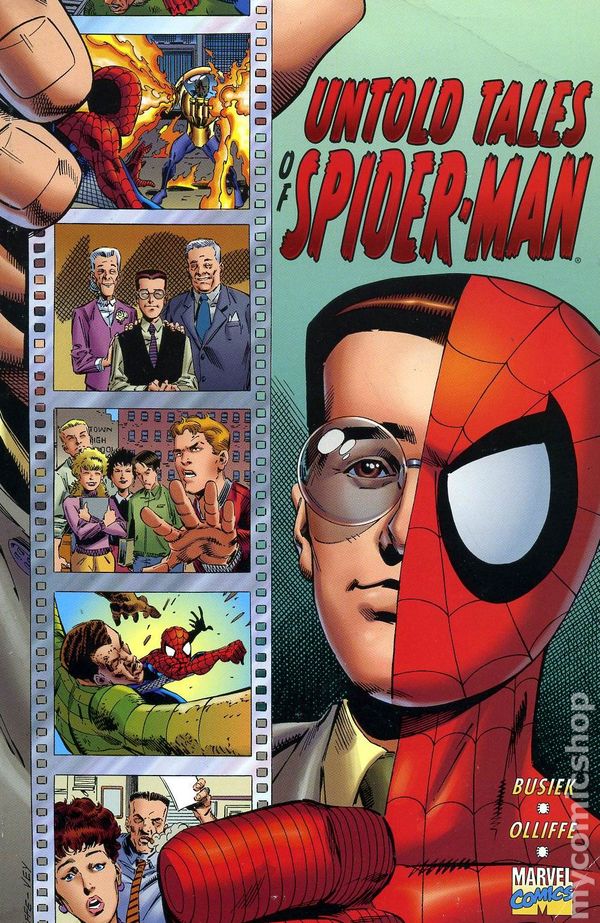
UNTOLD TALES OF SPIDER-MAN TRADE PAPERBACK: And speaking of things that were all my own fault, this one here is the king mother of them all. Every year, I do a seminar for Marvel’s junior editors, and every year, I close out that talk with a bit about not falling prey to ego or pride. It’s a firsthand lesson because that’s absolutely what happened to me here, and it almost cost me my livelihood, probably closer than any of the previous instances.
UNTOLD TALES OF SPIDER-MAN had been conceived as a part of a line of affordable 99 cent titles aimed at a Newsstand audience. Unfortunately, that experiment was a bit of a bust, as the Newsstand retailers didn’t want a 99 cent product–they didn’t realize enough of a return on each copy sold–and so the books were released in that marketplace as flip books, combined with another entry in the line. However, UTOS’ single issue stories set during the earliest issues of the Lee and Ditko AMAZING SPIDER-MAN and produced by Kurt Busiek and Pat Olliffe caught the fancy of a number of older Spider-Man readers who felt disenfranchised by the ongoing Clone Saga and the notion that Ben Reilly had been the real Spider-Man all along. The sales on UNTOLD TALES never did better than a third as well as the core Spider-Man books, but it was a bit of a fan favorite, one of those books that was well-loved by a certain vocal segment of the audience. And so it outlasted the other 99 cent titles by a good margin.
It also received a Trade paperback collection, at a time when Marvel still didn’t have a truly active TPB program in place. Marvel would do Trade paperbacks, but haphazardly, without much rhyme or reason. At this late date, I don’t remember whether I was the one who pushed for an UTOS collection (I likely was) or whether it was somebody else who proposed it, but however it happened, the book was a go. We even got a small budget to allow Pat to do a brand new cover for it, which you see up above.
And here’s where ego enters into it. On the back cover of the volume, we determined that we’d run a bunch of pull-quotes from the positive press the series had garnered. And there was one quote in particular that I was hot to include. It said something along the lines of, “Every month, Marvel puts out half a dozen Spider-Man comics. Most of them suck outright. The sole exception is UNTOLD TALES OF SPIDER-MAN, which blah blah blah.” I delighted in that quote, in part because it mirrored my own assessment of the relative quality of the material, and so in my arrogance I decided to include it on the book. Just to be clear: if one of Marvel’s young editors did this today, I would drop-kick them into the sun. It’s wholly inappropriate to be trashing other releases in your line within the line itself, to say nothing of disrespectful to the creators of those books. It was a crappy thing to do, but so full of myself was I that I made sure that it was included–counting on EIC Bob Harras to not look over the cover too closely when it was sent to print. Which, indeed, he didn’t.
I probably came the closest to losing my gig in this instance than any other. Our publisher of the period, Shirrel Rhodes, wanted to fire me immediately, and I can’t really blame him. To this day, I’m not quite certain what saved me, apart from the fact that everything was chaos and there was likely some other new emergency to cope with the following day. And ultimately, I wound up having to write an apology to the other Spider-Man creators that ran on the UNTOLD TALES letters page–which was something that by that point I considered appropriate. This was a stupid, amateur move all around, and ultimately it was all for nothing–that quote didn’t sell a single additional copy, nor did it make anybody think that I was some sort of editorial genius or anything. A bad decision on my part all around. If you’re an editor, beware of your ego.

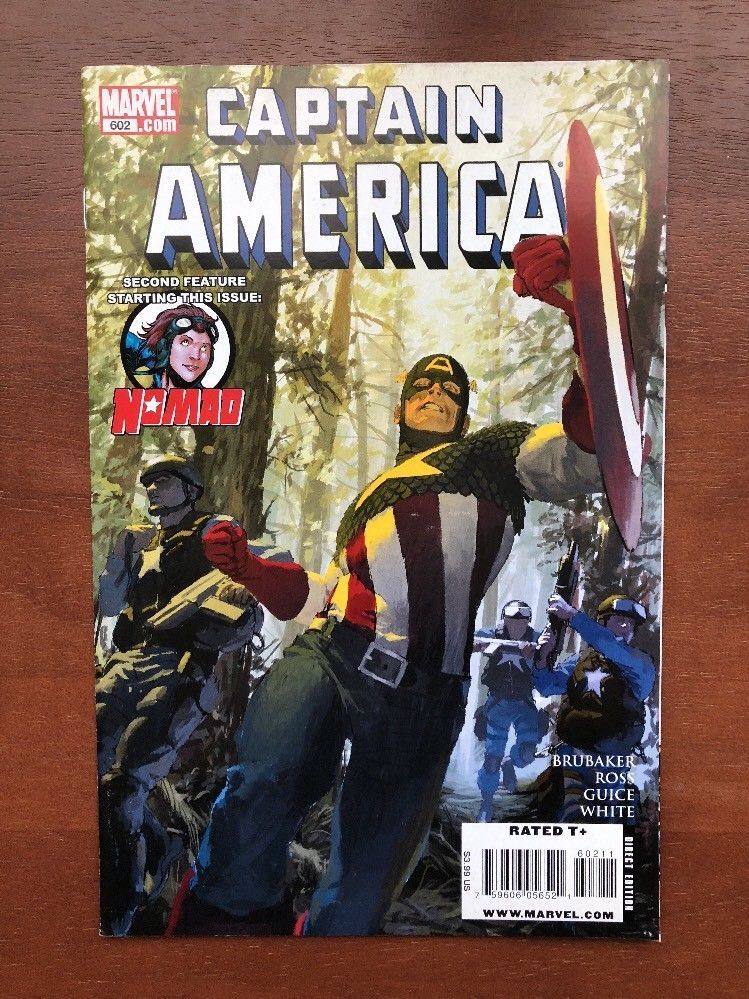
CAPTAIN AMERICA #602: Now this one was simply a domino effect of choices that got out of hand, a complete accident. But one that spawned a bit of a firestorm before things died down. This issue of CAPTAIN AMERICA came out during the back half of writer Ed Brubaker’s long run on teh character, and directly after the triple-threat situation of putting out the oversized CAP #50, the gargantuan CAP #600 and then the oversized and special CAP #601 with its Gene Colan-illustrated story (which was also released in a pencils-only format) So we were all burning the candle at both ends. Anyway, at this point in the narrative, Steve Rogers was still dead, and Bucky Barnes had taken over the role of Captain America. And as a counterpoint to Bucky’s position as the Star-Spangled Avenger, Ed decided to bring back the Captain America of teh 1950s as a character. That Cap had been warped by the imperfect super-soldier serum that empowered him into a paranoid super-patriot. But he looked like the classic Cap, so he made for a compelling antagonist for Bucky.
In any case, the specifics of the storyline don’t have a whole lot to do with what actually went down here. See, on a particular page of this issue, artist Luke Ross had drawn a bunch of protestors holding up signs, but he’d left the text itself to be filled in by the letterer. Ed hadn’t specified any particular copy for those signs, and it was late on a Friday night as myself and my assistant were scrambling to get this book and other books off to the printer so that we could go home for the weekend. So we asked the letterer to fill in some text on those signs, he googled protests and pulled some slogans off of recent images that he found, and we sent the book to print and didn’t think much about it. Actually, that’s not quite true–when we sent a copy of the finished book to Ed to look over, he was uneasy with the reference to the Tea Party on one of the signs, and so we went and changed it for its eventual publication in collected edition form. And then we didn’t think anything much of it.
Until the week that the book saw print, and all hell broke loose. I probably should have been more aware of how things might play out given the fact that the death of Captain America had made front page news only a year or so earlier. But there was an outcry from Tea Party-sympathetic readers, and Fox News did a story on it, and all of a sudden we were all in the middle of a whirlwind. And nobody who was offended wanted to hear or to believe that the whole thing had simply been unintended on the part of those involved. As you’d expect, there were calls for Ed’s head, calls for my head (or at least the head of the editor of CAPTAIN AMERICA, who was me), calls for Joe Quesada’s head and for all I know calls for Spider-Man’s head as well. Eventually, the news cycle moved on and things died down–at least until we did another story in CAPTAIN AMERICA. But that is literally another story.
And as far as I can tell, my livelihood wasn’t in any jeopardy from this occurrence. Those involved were able to see clearly that the whole thing was a gaffe in the first lace, and one that we’d already corrected for future printings–as it has been ever since. But it still made for a tense morning and a tense train ride into the office before I could find out just what was going on and explain the particulars to everybody. So this entry is a bit of a cheat to get us up to five–but it’s close enough that I feel as though it counts.
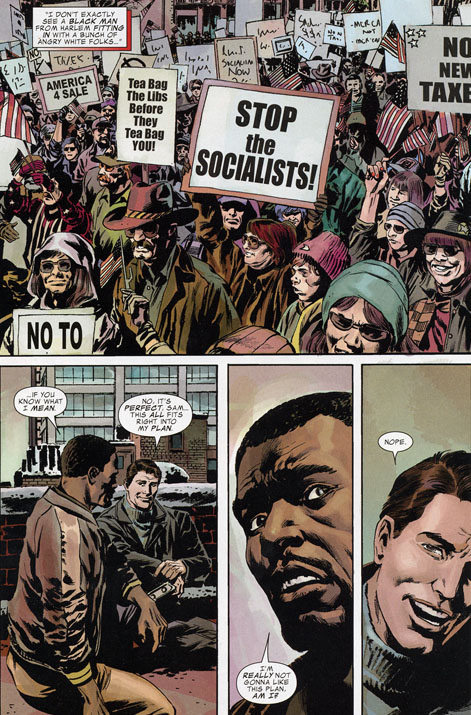

I remember several of those — especially the UNTOLD TALES one, of course. I found it funny at the time, though understandably trouble. But I didn’t know it almost got you fired, I think.
LikeLiked by 1 person
I don’t miss 90% of Marvel’s 90’s output. First exceptions 5hat come to mind are Mark Waid & Ron Garney’s Captain America series, & JM DeMatais (spelling is orobably way off) & Garney’s Silver Surfer.
Shame about Gerber. And Budianski.
I do miss Oat Oliffe.
Wow, that cover to Cap 692 is gorgeous.
I remember the tea bag controversy like it was last year. 😆 LOL. Sticks & Stones… Hey, @ least you didn’t having them storming the US Capitol…building…
LikeLike
Yikes. PAT OLIFFE. “Oat Oliffe” sounds like a bad name for some Nordic enforcer character, friends with Man Mountain Marko. .
And I .meant the cover to Cap #602. Sheesh.
LikeLike
Tim, thank you for a perfect ending of a perfect day. When a reply to a blog entry about mistakes and apologies, itself has mistakes and a follow-up apologies, it reminds me of what a delightfully ironic and funny life this is.
LikeLiked by 1 person
Yoor wellkum. 😉
LikeLike